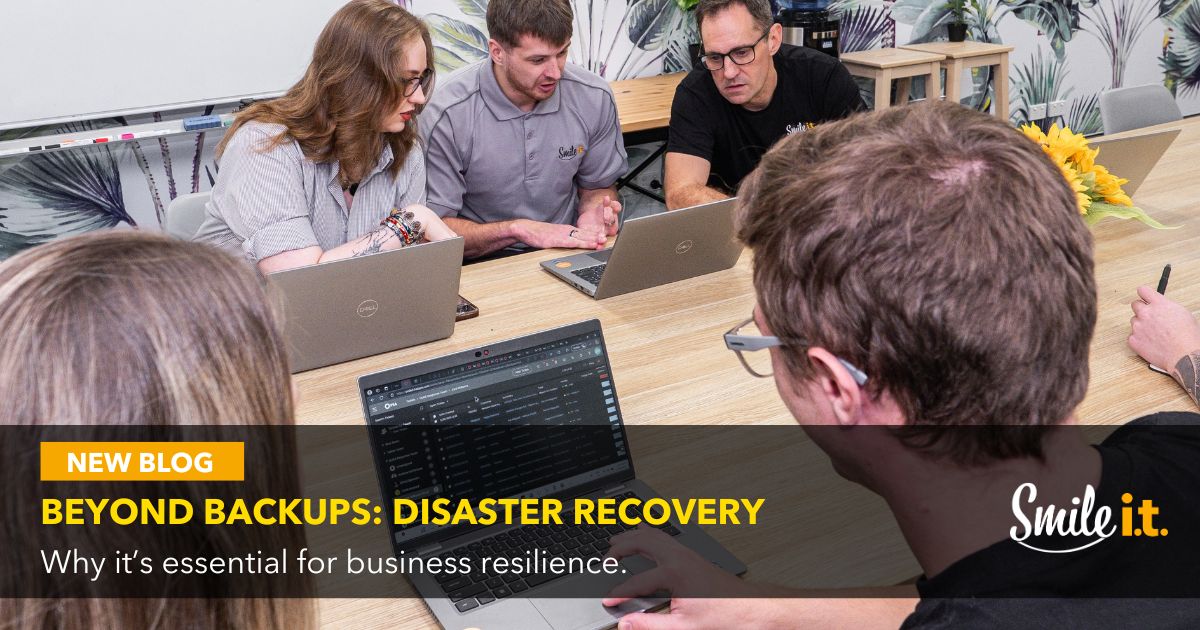Most business owners feel a sense of relief once they’ve set up backups. Files are copied. Data is safe. Box ticked. But – there’s always a but – backups on their own aren’t a business continuity magic bullet. It needs to be part of a bigger picture – and that bigger picture is known as ‘disaster recovery’. We’re going to look at what this is, how it differs from backups and how the two dovetail to help get your business back up and running in the event of a disruption.
What is Disaster Recovery?
According to Microsoft, ‘Disaster recovery refers to the methods, practices, and technologies organisations use to restore data and IT access after a technology-related disaster.’
A disruptive event, such as a cyber attack, human error, or a physical disaster like a fire, can absolutely floor your business. Disaster recovery helps mitigate the damage by getting your IT systems up and running ASAP so your core business functions can get going again.
Backups vs Disaster Recovery: What’s the Difference?

Disaster recovery is all about the comeback. Your disaster recovery plan should cover how fast systems will be restored and the process to do so. It takes into account the data itself too – how much your business can afford to lose? What is the core essential data that needs to be focused on first in the recovery? What’s plan B if we run into a challenge like a server encryption or a flooded office?
While having the backups gives you peace of mind, the true continuity comes from the overall disaster recovery process.
Why Backups Alone Fall Short
Your data backup is your safety net – a protective measure for your digital assets. Regular backups take the sting out of accidentally deleting a file or your computer crashing and losing data. You can just restore it from the backup.
Let’s look at slightly more disruptive examples. Say your entire network is hit by ransomware, and the servers are encrypted by the hackers. That’s where your backups were stored- so what happens now?
Or maybe the Brisbane River bursts its banks again and suddenly your office is in four feet of water – enough to cover those on-premises backups you had in the server room. What do you do then?
If you’ve only invested in backups and not in disaster recovery, the scenarios above are going to have huge impacts. The downtime will extend on and on – sales will stop, customers will walk away, staff will be twiddling their thumbs. It’s an expensive and stressful time, and often the cost of a single day offline will dwarf the cost of investing in a disaster recovery strategy.
What Disaster Recovery Brings to the Table
When defining your disaster recovery, there are two metrics to take into account:
- RTO (Recovery Time Objective): The maximum time your systems can be down before significant consequences start to be felt.
- RPO (Recovery Point Objective): A time-based measurement of the maximum amount of data your business can afford to lose.
Knowing and understanding RTO and RPO will shape the strategy you build, test and implement. There’s more to disaster recovery than these two metrics, though. It provides structure to ensure continuity, with failsafes and Plan Bs to cover all manners of disruption. For example:
- Offsite redundancy that doesn’t drown when your office floods.
- Failover systems that let staff continue working while repairs happen.
- Regular testing that shows the plan isn’t just a theory and it works in practice.
Disaster Recovery Use Cases

A retailer hit by a cyberattack manages to continue trading because their cloud-based recovery system builds new servers in hours. Without it, they’d have been offline for days.
A law firm loses access to its case files after accidental deletion. Because they had a disaster recovery plan, they restored the database from a secure copy in less than an afternoon and clients never knew there was a problem.
A huge storm cuts the power to a factory. Disaster recovery allowed them to re-route operations through a secondary site, so production keeps moving.
Building Your DR Strategy
Knowing where to start with business backups and disaster recovery can be overwhelming. Here are a couple of pointers that may reduce that:
- Think in layers when it comes to your backups – have a local backup plus cloud storage.
- Test the plan. A backup you’ve never restored is more of a gamble than a guarantee.
- Set your numbers. Know your RTO and RPO, and build solutions that meet them.
- Train your people. It’s essential to have a team that knows, understands and is engaged with your disaster recovery plan.
The point isn’t to prepare for every possible scenario. It’s to create resilience. To know that whatever happens, you can pick up the pieces quickly.
Backups and Disaster Recovery with Smile IT
Hopefully you’ve got a bit of insight now into why backups alone aren’t sufficient for your business resilience. They’re necessary, but they stop short of what matters most: keeping your business running in spite of a crisis.
Disaster recovery fills that gap, transforming data protection into business continuity.
At Smile IT, we want your business to be ready for anything. We’re here to answer any questions you have about disaster recovery and can help you setup and build a plan that works.
Get in touch today.
When he’s not writing tech articles or turning IT startups into established and consistent managed service providers, Peter Drummond can be found kitesurfing on the Gold Coast or hanging out with his family!


